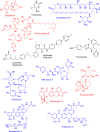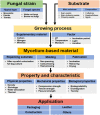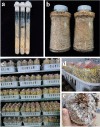Ten decadal advances in fungal biology leading towards human well-being
- PMID: 36123995
- PMCID: PMC9476466
- DOI: 10.1007/s13225-022-00510-3
Ten decadal advances in fungal biology leading towards human well-being
Abstract
Fungi are an understudied resource possessing huge potential for developing products that can greatly improve human well-being. In the current paper, we highlight some important discoveries and developments in applied mycology and interdisciplinary Life Science research. These examples concern recently introduced drugs for the treatment of infections and neurological diseases; application of -OMICS techniques and genetic tools in medical mycology and the regulation of mycotoxin production; as well as some highlights of mushroom cultivaton in Asia. Examples for new diagnostic tools in medical mycology and the exploitation of new candidates for therapeutic drugs, are also given. In addition, two entries illustrating the latest developments in the use of fungi for biodegradation and fungal biomaterial production are provided. Some other areas where there have been and/or will be significant developments are also included. It is our hope that this paper will help realise the importance of fungi as a potential industrial resource and see the next two decades bring forward many new fungal and fungus-derived products.
Keywords: Biomaterial; CRISPR; Drug development; Morel cultivation; Mushroom cultivation; Mycotoxin biosynthesis; Plastic degradation.
© The Author(s) 2022.
Conflict of interest statement
Conflict of interestThe authors declare no conflict of interest.
Figures




















References
-
- Abe M, Kobayashi K, Honma N, Nakasaki K. Microbial degradation of poly(butylenes succinate) by Fusarium solani in soil environments. Polym Degrad Stab. 2010;95:138–143. doi: 10.1016/j.polymdegradstab.2009.11.042. - DOI
-
- Abhijith R, Ashok A, Rejeesh CR (2018) Sustainable packaging applications from mycelium to substitute polystyrene: a review. In: Materials today: proceedings, Agartala, India, pp 2139–214
-
- Abraham J, Ghosh E, Mukherjee P, et al. Microbial degradation of low density polyethylene. Environ Prog Sustain Energy. 2017;36:147–154. doi: 10.1002/ep.12467. - DOI
Publication types
Grants and funding
LinkOut - more resources
Full Text Sources
